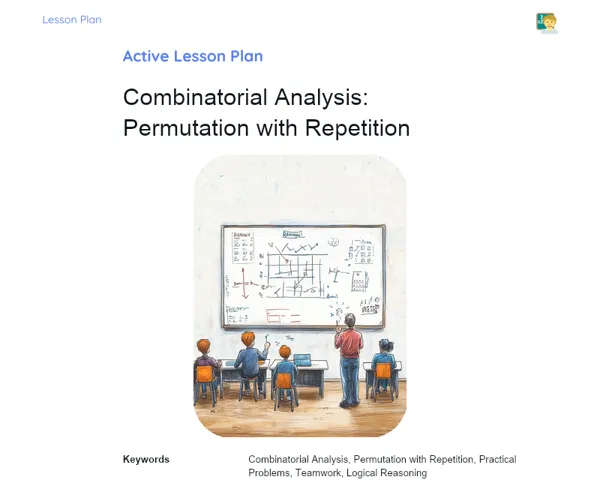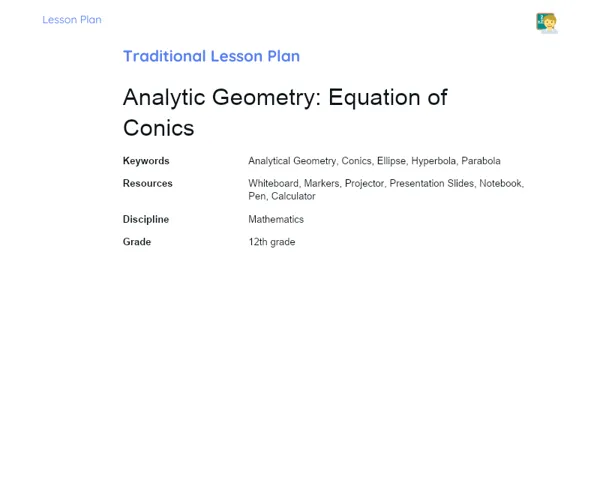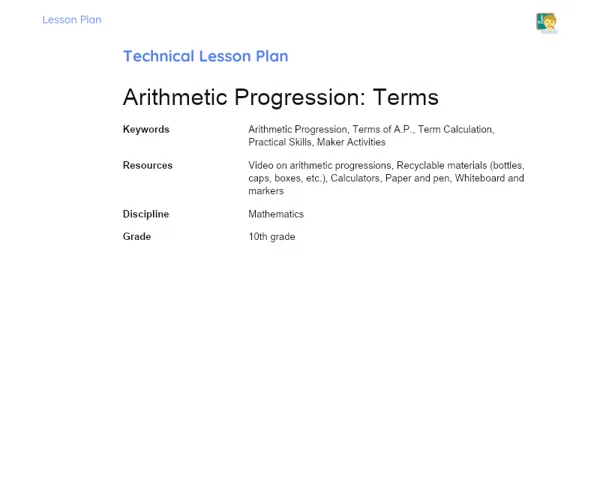Lesson Plan Teknis | Rotations of Plane Figures
| Palavras Chave | Rotating Plane Figures, Geometry, Spatial Visualization, Practical Application, Maker Activities, Rotation Symmetries, Rotated Triangle, Graphic Design, Engineering, Architecture, Mandala, Mathematics, 7th Grade, Relevant Skills, Job Market |
| Materiais Necessários | Graph paper, Rulers, Compass, Pencils, Demonstration video of figure rotations in graphic design software, Projector or screen for video display |
Objective
Duration: 10 - 15 minutes
This lesson plan aims to provide students with a solid and practical understanding of rotating plane figures. This skill is not only essential for math in school but also highly valued in various technical and engineering careers. Mastering this will help students visualize and manipulate objects in a two-dimensional space, a competency that is increasingly sought after in the job market.
Objective Utama:
1. Understand the concept of rotating plane figures.
2. Identify figures resulting from specific rotations, such as 90º.
3. Apply rotation knowledge to solve practical problems.
Objective Sampingan:
- Develop spatial visualization skills.
- Encourage connections between mathematical concepts and their real-world applications.
Introduction
Duration: 10 - 15 minutes
The goal of this initial stage is to pique students' interest in the topic by illustrating the significance of rotating plane figures in real-life contexts and the job market. By contextualizing the subject and introducing intriguing facts, students will feel motivated to engage actively in the following activities.
Curiosities and Market Connection
Did you know that the rotation of figures plays a significant role in computer graphics and animation? Companies in gaming and film employ this concept for creating dynamic movements and transforming images. Moreover, in sectors like engineering and architecture, mastering figure rotations is crucial for developing precise models and simulations, allowing professionals to handle complex and innovative projects.
Contextualization
Rotating plane figures form the basis of geometry and find practical applications in numerous fields. For instance, the design of amusement parks relies on correctly rotating and positioning rides to optimize space while ensuring visitor safety. Understanding rotations can aid in solving practical problems, such as arranging classroom seating or creating effective logo designs.
Initial Activity
Kick off the lesson with an engaging question: 'How do you think video game developers create lifelike movements for their characters?' Then, present a short video demonstrating the rotation of figures using graphic design software, showcasing how these skills are essential for making animations and visual effects.
Development
Duration: 55 - 60 minutes
The aim of this segment is to deepen students' grasp of plane figure rotations through practical and interactive tasks. By creating mandalas, students can visualize and artistically apply the concept of rotation while also tackling real-world challenges that reinforce their theoretical understanding. These activities are designed to enhance spatial visualization skills and connect math concepts to practical situations.
Topics
1. Concept of rotating plane figures
2. Identifying figures after specific rotations (e.g., 90º, 180º, 270º)
3. Practical application of rotations in everyday scenarios
Thoughts on the Subject
Encourage students to consider how they encounter rotations of plane figures in their daily routines, such as turning a key in a lock, rearranging furniture, or noticing the movement of clock hands. Discuss how these rotations impact both the functionality and aesthetics of everyday objects.
Mini Challenge
Creating Mandalas with Rotations
Students will design mandalas by using rotations of basic geometric shapes. This creative activity will help them visualize and comprehend rotations practically.
1. Form groups of 3 to 4 students.
2. Provide graph paper, rulers, compasses, and pencils to each group.
3. Instruct them to draw a simple geometric figure (triangle, square, etc.) at the center of the paper.
4. Guide them to rotate the figure by 90º, 180º, and 270º around the center point.
5. Ask the students to repeat this with different geometric figures, resulting in a symmetrical and artistic design.
6. Finally, each group should present their mandala to the class and explain the rotation process used.
Enable students to practically and creatively visualize and understand the rotations of plane figures, thereby enhancing their spatial visualization skills.
**Duration: 35 - 40 minutes
Evaluation Exercises
1. Draw a triangle and rotate it 90º around a fixed point, then illustrate its new position.
2. Explain how a 180º rotation alters the position of a square on a plane.
3. Rotate a hexagon by 270º and sketch the resulting figure.
4. Work on practical rotation scenarios, such as fitting pieces of a jigsaw puzzle that require rotation.
Conclusion
Duration: 15 - 20 minutes
This phase of the lesson plan aims to consolidate students' learning, facilitating a review of the main ideas and reflecting on the significance of rotating plane figures in practical and professional scenarios. This stage also seeks to prompt students to recognize the application of mathematical concepts in real-life contexts, fostering a more meaningful and interconnected learning experience relevant to the job market.
Discussion
Encourage a conversation about how the rotations of plane figures were utilized during the lesson, starting from the mandalas creation and exploring how this exercise illuminated the concepts of 90º, 180º, and 270º rotations. Ask students to consider how this skill could benefit them in careers like graphic design, engineering, or architecture. Invite them to share their experiences while solving fixation exercises and practical tasks, and reflect on the role of spatial visualization in their daily lives.
Summary
Recap the key points discussed in the lesson, emphasizing the rotation of plane figures and the identification of figures resulting from specific rotations. Reinforce how theory was applied through mandala creation and fixation exercises. Explain how these activities aided in developing spatial visualization skills and cemented their understanding of rotations in a concrete manner.
Closing
Discuss how the lesson tied together theory, practice, and applications, underlining the importance of rotating plane figures in various professional fields and everyday life. Reference practical examples explored during the lesson, such as logo design, game development, and spatial arrangement. Wrap up by stressing how mastering this skill equips students to solve real-world issues and innovate across different industries.



